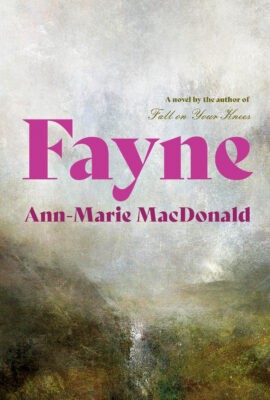What is light? Particle, wave – or both? Such questions preoccupy the Honourable Charlotte Bell, ahead of her time in the late nineteenth century. Insatiably curious, Charlotte is entering adolescence at Fayne, a remote estate comprised of thousands of acres of mysterious moorland, “situated on the southern border of Scotland – or the northern border of England, as the case may be.” This bewitching land – which is at once two lands – foreshadows Charlotte’s awakening towards her own identity.
Weighing in at 736 pages, Fayne, Ann-Marie MacDonald’s magnificent fourth novel, is a hefty read, yet never does it feel too long. Here, the best-selling author skillfully marries the mystical with the scientific, her nature-honouring opus illuminated with flashes of humour. She explores timeless themes like loyalty and betrayal within love and friendship, while addressing issues of gender and sex with great depth and sensitivity. At the centre of it all, amid scenery fit for a fairytale, lively Charlotte holds readers rapt as she untangles family secrets coiled at the heart of intergenerational wounds.
Fayne Knopf Canada
Ann-Marie MacDonald
$40.00
736pp
9780735276635
In her mother’s absence, gifted Charlotte is lovingly home-schooled by her gentlemanly father, Lord Henry. Yet, she’s already asking questions outside his wheelhouse. “What is colour?” she inquires, hungry for scientific details. When she begs to be sent to school, the protective baron hires a home tutor, Mr. Margalo, who can’t help but doubt his feisty new student’s “condition.” Intrepid Charlotte rejects prevailing norms and aspires to become a physician in an era unkind to women scholars. She’s also intrigued by emerging research in physics that hints at wave-particle duality, a compelling paradox that matches her intuitions about the nature of reality: “Mr. Margalo, in this world of scientific wonders,” she suggests, “might we not one day discover that two opposite states might indeed coexist?”
The young protagonist’s first friend, Gwendolyn, provides another window to the outside world. Meanwhile, Charlotte’s inner sight progressively sharpens. In dreams, clues crop up around the suspicious deaths of her mother and brother.
As the narrative shifts back and forth in time, the reader enjoys a rainbow of viewpoints, experiencing the family’s drama through Charlotte’s mother, father, aunt, and others. This colourful tapestry, interwoven with fortune, tragedy, and empathy, provides the backdrop for Charlotte’s struggle to transcend oppressive cultural conditioning and protect a body that diverges from society’s cookie-cutter standards. This personal fight is echoed by a more universal challenge when industry threatens to encroach on Fenn, a moorland that embodies an increasingly rare wilderness, still rich with the very biodiversity upon which human life depends.
“Let us cherish the mud, and cultivate compassion for the stars,” invites Charlotte, by now equally plugged into subtle energies and the material world, and wise to our species’ tragic knack for destruction. In a moving and poetic finale, the unforgettable Fayne slips beneath one’s skin like an electric enchantment. Smudged with mud and marsh sprite dust, this reader turned the final pages wired in awe, keenly aware of our impermanence – strung with infinity’s fairy lights.mRb






I loved this book. It reads like poetry and at the same time a scientific journal. The story was so intriguing I never wanted it to end.
Ann Marie MacDonalds books are always captivating but Fayne stands alone for me. The research and intelligence is mind boggling.
I understand why there are a few years between her books..
It’s a page turner alright, I turned the pages and scanned the book, my gawd the author blathers on forEVER. And the story line is boring and kind of predictable. Can’t believe the reviewer above “never wanted it to end” and I just couldn’t Wait for it to end. Skip it, unless your into “poetry”, just ugh!
Sounds like it was lost on you completely, too bad
This novel is a masterclass in language, plot, character and theme. Reading Fayne is like reading Dickens, Tolstoy and Austin rolled into one fabulous Victorian tome. I never wanted it to end but couldn’t stop reading.
A twenty-first century Dickens — it is all beautifully there. Thank you for Fayne, Ann Marie MacDonald. Greatly appreciated by this Reader.
A beautifully written gem of a novel, this has become my favourite Ann-Marie MacDonald book- a feat in itself.
A fascinating rich story, a real Tour de Force, 722 p. and all threads extremely well tied. The research which went into writing this saga is absolutely extraordinary. Challenging at times for a French Canadian. A
great page turner.
A little slow to start. I’m consumed by plot and the rich textual narrative took some determination to persevere through, but 50 pages in I was hooked and couldn’t put it down. So mystical, so provocative — from a philosophical, scientific, and spiritual sense I marveled at Ann-Marie’s ability to interweave things. If I could criticize ever so slightly, the reach — people, places, and ideas — is so vast, it would help to visualize a cast of characters, but such a graph would have to be so-o-o-o dynamic so as not to give away the intricacies of the plot that she reveals to agonizingly drip by drip.
What an achievement!